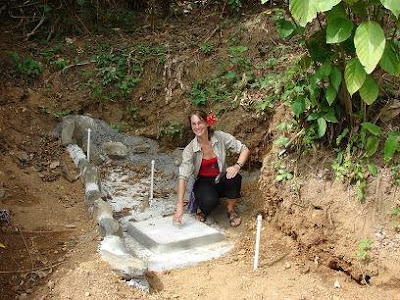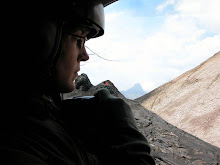
Jose Abrego / For The TimesAlexandra Hodgkins, left, of New Hampshire and Yemiymah Yisrael of Chicago are volunteering with the Peace Corps in Santa Fe, Panama. Yisrael extended her stay.
More Americans turning to Peace Corps
With President Obama extolling the volunteer agency as an exemplar of public service and U.S. diplomacy, applications have jumped. The idealism is tinged with pragmatism, amid joblessness at home.
By Chris Kraul
June 2, 2009
Reporting from Santa Fe, Panama -- Peace Corps volunteer Alexandra Hodgkins couldn't be farther from her comfort zone here in Panama's Darien jungle: coral snakes, sauna-like heat and, just a few miles east up the Pan-American Highway, marauding Colombian rebels.
But the 25-year-old New Hampshire native wants a career in international development, and she figures a couple of years helping this poor community find permits and financing for a medicinal soap business will be invaluable experience. It also feeds her passion for public service and projecting a positive U.S. image.
"This is a good way to test whether this is what I want to do," said Hodgkins, who was a community organizer in Boston before she joined the Peace Corps in October. "I like the Peace Corps approach of working with communities, not just giving out presents right and left."
With a mix of idealism and pragmatism, increasing numbers of Americans are turning to the Peace Corps. Some, like Hodgkins, see it as a training opportunity at a time when job prospects at home are bleak. Others have been inspired by President Obama's campaign call to public service, and his frequent mention of the Peace Corps as a good vehicle for volunteerism.
At his commencement address at Arizona State University last month, Obama said the Peace Corps was an American institution that shows "our commitment to working with other nations to pursue the ideals of opportunity, equality and freedom that have made us who we are."
Peace Corps officials credit the "Obama effect" for most of the 25,000 Internet requests so far this year for "starter applications," up 40% from last year.
That's on top of a 16% increase in completed applications submitted in 2008. A new wrinkle to the flood of application requests is that 7% of them are coming from people 50 or older, up from the typical 4%, says the Washington-based organization.
Even as some government programs are being scaled back because of the global financial crisis, the Peace Corps' budget is getting a boost from Obama. If Congress approves the proposed 9% increase in the agency's 2010 budget, the number of Peace Corps volunteers, now at 7,876, is expected to rise.
"We are just skyrocketing in applications," said Peace Corps acting director Jody Olsen, who expects the volunteer ranks to grow significantly this year. "Obama represents what Americans really want to be asked to do. We want to hear how important service is, whether it is domestic or international."
These are good times for the Peace Corps, which was founded by President Kennedy in 1961. It has had its ups and downs, peaking at 15,000 volunteers in 1966 and hitting a low of fewer than 5,000 in 1982.
"It's refreshing and uplifting to witness this sort of outpouring of American idealism again, particularly after the U.S. reputation has suffered such setbacks as Abu Ghraib and Guantanamo," said Bruce Bagley, a University of Miami political science professor and a Peace Corps volunteer in Colombia in the late 1960s.
Olsen said 20 countries that have no Peace Corps presence have asked for volunteers, with specialists in farming, English teaching, and HIV/AIDS and hygiene awareness the most in demand. The requests reflect the agency's proven effectiveness, she said. But budget and logistical restrictions mean that most requests will not be met.
On a positive note, the Peace Corps is returning to Rwanda, Liberia and Ethiopia for the first time in a decade or more. Here in Panama, the number of volunteers has steadily increased to 160 from 100 five years ago, said country director Peter Redmond. He said the upturn was due in large part to the fact that the country values and seeks volunteers.
But the final number of volunteers the U.S. sends out will depend on whether Congress passes Obama's $380-million budget request for the next fiscal year.
It's not a slam dunk. The program's cost-effectiveness has been a source of debate over its 48-year history, with some critics contending that the Peace Corps is a form of "developmental tourism" and that some volunteers at times drift aimlessly in their communities during their two-year tours.
U.S. diplomat Dale Maki disagrees vigorously. Maki is a former Peace Corps volunteer in Chile and is now an agriculture advisor at the U.S. Embassy in Panama. He said volunteering benefits the United States because it "develops leadership and puts a good face on the U.S. out there."
In addition to scores of former volunteers who, like Maki, have gone on to join the U.S. foreign service, five are members of Congress, including Democratic Sen. Christopher J. Dodd of Connecticut.
Charles Goodsell, a Virginia Tech professor emeritus who is writing a book on the Peace Corps and other government institutions, said the critics are wrong.
"The Peace Corps is very hard work. It takes a lot of creativity to be effective in often lonely circumstances and where the tasks are not perfectly outlined," Goodsell said. "In fact, the whole idea is that individual volunteers not show up with prepackaged plans but find out what the locals really need."
Santa Fe resident Marcelina Noriega says that's what Hodgkins did, helping her cooperative cut through red tape and the application process to get a $20,000 United Nations grant.
Now the cooperative has its sights set on setting up an iguana farm to sell the skins and meat. "She has helped us do things we had no idea about," Noriega said.
Yemiymah Yisrael, a 26-year-old volunteer from Chicago who has spent three years in Santa Fe teaching composting techniques, extended her stay partly because of the lousy economy back home.
"Several volunteers who have gone home have advised me not to because it's so difficult to find a job," said Yisrael, who has her eye on a career in international health. Before the Peace Corps, she did carpentry work with Habitat for Humanity rebuilding hurricane victims' homes.
Not that the Peace Corps is lucrative: Hodgkins and Yisrael are paid about $320 a month, just above Panama's minimum wage.
Hodgkins said she gets discouraged at times by the delays and paperwork required by the Panamanian government.
"But if you keep an open mind and try to understand the culture," she said, "then you can do what you came to do."
Source:
http://www.latimes.com/news/nationworld/world/la-fg-peacecorps2-2009jun02,0,2239945.storyKraul is a special correspondent.

















































 A perfect triangular shadow appeared behind Volcán Barú against the blue Costa Rican backdrop. The yellow light touched the highest peaks and warmed up the grayscale views. The details of the world below 10,000 feet became fuzzy and then, suddenly everything was clear and brightening from the anticipated sunrise.
A perfect triangular shadow appeared behind Volcán Barú against the blue Costa Rican backdrop. The yellow light touched the highest peaks and warmed up the grayscale views. The details of the world below 10,000 feet became fuzzy and then, suddenly everything was clear and brightening from the anticipated sunrise. 






